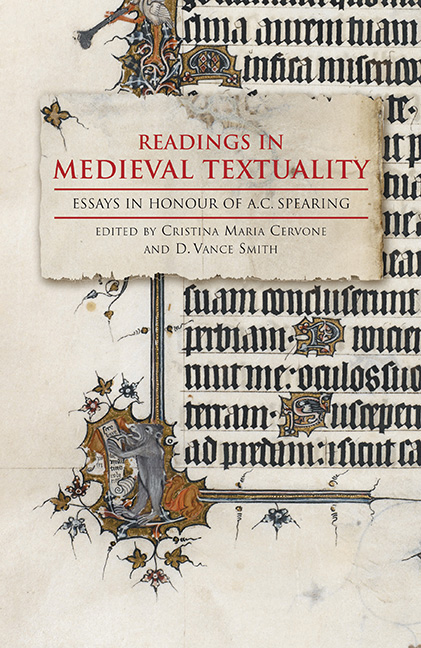Book contents
- Frontmatter
- Contents
- List of Illustrations
- List of Contributors
- A. C. Spearing's Work and Influence
- Bibliography of A. C. Spearing's Works
- I Reading Experience and Experientiality
- II Revisions and Re-visioning of Alliterative Poetry
- III Subjectivity and the Self
- IV Reading for Form
- 8 The Inescapability of Form
- 9 Destroyer of Forms: Chaucer's Philomela
- 10 Gower's Confessio Amantis and Chaucer's Canterbury Tales as Dits
- 11 Poems without Form? Maiden in the mor lay Revisited
- 12 “I” and “We” in Chaucer's Complaint unto Cervone Pity
- V Epilogue
- Works Cited
- Index
- Tabula Gratulatoria
10 - Gower's Confessio Amantis and Chaucer's Canterbury Tales as Dits
from IV - Reading for Form
Published online by Cambridge University Press: 25 October 2017
- Frontmatter
- Contents
- List of Illustrations
- List of Contributors
- A. C. Spearing's Work and Influence
- Bibliography of A. C. Spearing's Works
- I Reading Experience and Experientiality
- II Revisions and Re-visioning of Alliterative Poetry
- III Subjectivity and the Self
- IV Reading for Form
- 8 The Inescapability of Form
- 9 Destroyer of Forms: Chaucer's Philomela
- 10 Gower's Confessio Amantis and Chaucer's Canterbury Tales as Dits
- 11 Poems without Form? Maiden in the mor lay Revisited
- 12 “I” and “We” in Chaucer's Complaint unto Cervone Pity
- V Epilogue
- Works Cited
- Index
- Tabula Gratulatoria
Summary
Many years ago, the critic and poet J. V. Cunningham published an essay entitled “The Literary Form of the Prologue to the Canterbury Tales.” In this essay Cunningham objected to accounts of the poem that “have pictured Chaucer going directly to reality and reporting what he found” (172), instead of looking for what he calls the poem's “literary form.” He states his general argument thus: “The literary form to which the Prologue to the Canterbury Tales belongs and of which it is a special realization is the form of the dream-vision prologue in the tradition of the Romance of the Rose and of the associated French and English poems of the subsequent century and a half” (174).
It was unfortunate that Cunningham should have confined his references to the French poems entirely to the Roman de la Rose itself, for his case could have been much strengthened if he had taken account of other French evidence – not only other dream-poems but also, most particularly, the so-called dits. Dits are longish poems of first-person narrative in which the narrating “I” may, as in dream-poems, encounter personifications and divinities, but, apart from occasional swoons, he remains awake throughout. It is in this respect among others that dits invite comparison with Gower's Confessio Amantis and also, I shall argue, with Chaucer's Canterbury Tales. Both these poems have waking first-person narrators who participate in the action (not merely describing it, as in a poem such as the Owl and the Nightingale). Narratives of this kind were not commonplace at the time, as they are today. Indeed, they were sufficiently unusual to justify our looking to France, as Cunningham did, for models of such a “literary form.”
Chief among the writers whose dits circulated in England were Guillaume de Machaut and Jean Froissart. Two of Machaut's dits were certainly familiar to Chaucer, and very probably to Gower as well: the Jugement du Roy de Behaigne and the Remede de Fortune.
- Type
- Chapter
- Information
- Readings in Medieval TextualityEssays in Honour of A.C. Spearing, pp. 157 - 168Publisher: Boydell & BrewerPrint publication year: 2016



